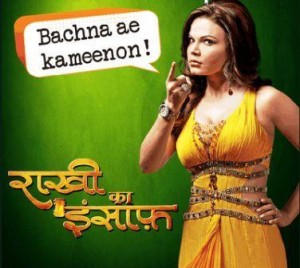Lately, TV content censorship and sanitization has become a contentious issue. While the conservative society claims that shows like Bigg Boss and Rakhi ka Insaaf, just to name the scapegoats, are obscene, controversial and violent, many others say that the content is only similar to the prevalent content of movies. Recently I&B ministry sent a notice to these shows asking them to change their timings so that they are not aired during the primetime viewing slots
Before we begin passing judgments, let’s examine what constitutes obscene or violent, who does this affect, and what is of far greater importance, whether we can do something about it.
Who draws the line and where do they draw it?
Culture, sense and sensibility are vague and abstract terms. So while a certain portrayal may be sensual, happening, or even liberating for one person, others may find it offensive and plainly unacceptable. The point is, there is a fine line between vulgarity and sensuality, between violence and adventure and between reality and gore. The inevitable question remains – who draws the line? Whose standards are accepted as the norm?
[ad#post-large]
TV’s are a part of every household and it is never easy to control the content which your children or other members of the family are viewing. Also, our family fabric has several people of different ages who all watch prime time TV together, so it’s obviously in the viewers’ interest that the shows on TV should be suitable viewing for everyone.
Some commonly used tactics to grab “eyeballs “
There are several tactics channels are employing to grab eye balls. These include showing intimate or sexual behavior under the pretence of “exposing” that person or under the guise of reality shows (quite a rage nowadays, these!!). Here are some of the top ones:
Get into their bedrooms:
Shows such as ‘Bindaas Emotional Atyachar’ take it upon themselves to expose the errant lover and happily intrude upon the privacy of the unsuspecting victim. Another show ‘Axe your Ex’ ensures that the ex is duly punished for ditching the litigant. Sure enough, their identities are revealed only after they sign the no-objection certificate for the channel but the shows’ content definitely trivializes the relationships in the young viewer’s mind. Hence, while the shows effectively make the errant lover pay for his/her deed, the viewer enjoys watching with voyeuristic glee as the unsuspecting “suspect” kisses their “secret agent”. Not so long back, a not-so-popular reality show called ‘Iss Jungle Se Mujhe Bachao’ showed contestants bathing openly and in minimal clothing. So, the steamier it gets in there, the better for the TRPs.

Promote mob mentality:
More than the violence and name-calling on Rakhi ka Insaaf, the “insaaf” which is delivered as a result of the shouting mob and a provocatively dressed actress, better known as an “item girl”, reminds you of the times when people used to stone adulterous women as part of their punishment. So, while the public cheers and jeers and Ms. Sawant reprimands (in the crudest manner possible) people for their errors in judgment, the viewer feels a sense of déjà-vu of the times when ‘Rajni’ used to ensure that justice was delivered in a more tasteful and definitely legal manner.
Show controversial scenes:
Bigg Boss has been showing “daring” stuff since season 1 and when the whole family sat down at 9:00 pm to watch prime time television, they were treated to the sight of men getting massages from a friend, or a gangster’s moll and a failed son of a politician cozying up when the lights went out late at night. Another hugely popular show, especially amongst the younger lot, ‘Roadies’ garners high TRPs for their auditions where the contestants are intimidated by shouting and foul-mouthing judges. Somehow we seem to have lost track of the fact that glorifying bad behaviour or showing the infidelities of relationships is not what we would like our families to watch and imbibe. We expect TV to guide our children and not lead them down a path which no one approves of.

Even the commercials are sometimes crass and uncouth:
While the movies aired on television (whether Indian or foreign) are duly edited and censored (which leads to sudden breaks in the movies!), the same cannot be said about the serials and advertisements aired. Commercials on TV easily border on the lewd – remember some underwear ads where near-naked male models are seen with lipstick kiss marks all over the body, or the ones which aim at showing some condom or perfume/deo as a chick-magnet. While some suggestive ads get caught in the legal net, thanks to jealous competition (like the hugely popular “Ye to bada toingg hai” Amul Macho ad), many other run-of-the-mill ads easily get past the moral brigade and the only reaction they garner are some wide-eyed attention from teenagers or uneasy shifting on the sofa and flipping of channels when these ads are aired during “family-time programming”.
Surrogate advertisements such as the Bagpiper, Kingfisher, 8 PM sodas which are mainly liquor brands go unquestioned.
[ad#post-large]
In these rapidly changing times where the objectionable is fast becoming acceptable and cool is the mantra of the young, drawing the line is not easy. And even if “Chadhti Jawani” and “Kanta Laga” may not be permitted during prime time, TV production houses ensure that enough masala is available to entice their viewer.
What can we do?
What we need to emphasize to the channels is that programming remains entertaining without getting lewd, informative without getting insipid and progressive without getting out of hand. The viewer can only do so much where restraint is concerned and the onus is upon the authorities to scan and screen the content and relegate the acceptable but controversial content to late night slots. Also, programmes which just promote senseless name-calling without actually accomplishing anything, need to be pulled up. Once the producers get the message loud and clear, they’ll surely clean up their acts. The authorities only need to show them who’s the boss.
Leave a Reply